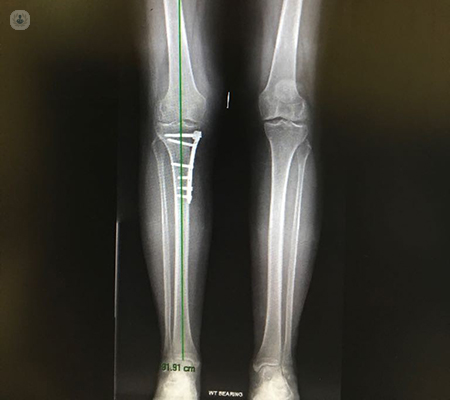Knee osteotomy vs. knee replacement surgery
Escrito por:Knee arthritis can cause pain and prevent you from doing the things you want to in life. Whilst painkillers can help to manage the pain, surgery, in various forms, can help to improve the condition overall. A knee joint replacement is one option, but an osteotomy is another.
Mr Minhal Chatoo, a leading orthopaedic surgeon, chooses an osteotomy to improve the symptoms of knee arthritis by preserving the knee joints, rather than replacing them. This is a revolutionary surgery which involves cutting the edges of the bones to straighten them and to realign the weight placed on your knees.
Knee osteotomy has become a procedure that has several advantages over knee joint replacement and can be considered in a significant number of patients with painful knee osteoarthritis.

The image shows an example of a closing wedge osteotomy on the shin bone (tibia) after the operation.
Who can have a knee osteotomy?
A knee osteotomy is usually recommended in younger patients who are still active with early-stage knee arthritis. However, as surgical techniques and planning are continually improved in safety and accuracy, knee osteotomy has been shown to be effective in older patients too who wish to avoid a total knee replacement.
What are the advantages of an osteotomy over a knee replacement?
The main advantages of an osteotomy are the reduction in associated pain, the preservation of the knee joint and delaying the need for a knee joint replacement. This option allows a younger patient to stay active and maintain an active lifestyle for many years. A knee replacement, on the other hand, has restrictions around what activities can be carried out following surgery, such as impact sports. Between 80-90% of patients have felt an improvement in their knee following an osteotomy. For patients whose arthritis progresses beyond this treatment, a knee replacement can always be considered later on.
How is a knee osteotomy performed?
In the past, before joint replacement surgery was possible, osteotomy was actually the standard technique used to treat osteoarthritis. However, due to certain inaccuracies in this technique in the past, results were mixed and didn’t have the level of success that a modern osteotomy has. In the past, an osteotomy carried the risk of over-alignment and subsequent pain, as well as the risk of nerve and blood vessel damage.
Hence, when knee joint replacement surgery was introduced, with successful results, the traditional osteotomy was left behind and reserved only for very young patients. However, with improved preoperative planning and modern surgical techniques, osteotomy has had a resurgence in the last ten to fifteen years and is a widely practised procedure in other parts of the world. It is not widely available in the UK due to the lack of experienced surgeons and the old prejudices held towards this procedure.
What about knee joint replacement surgery?
In general, the results of knee replacements are not as good as those of hip replacements. The National Joint Registry indicates that up to 20% of patients who have had a knee replacement without complication can be dissatisfied with their outcome. However, it is important to note that the knee joint is much more complex in structure than the hip, so recreating it is more complicated and has been shown to be less effective in younger patients.
Further disadvantages of knee replacement surgery include:
- Once the knee joint has been replaced with metal and plastic, any further problems experienced will need to be fixed with further surgery.
- Knee replacements have a limited lifespan, with eventual revision surgery being needed which can be very demanding on the patient.
- Infection or fracture around the knee joint can be devastating complications, particularly in younger patients, with further major surgery being required.
For more information about your options, make an appointment to see Mr Chatoo.


